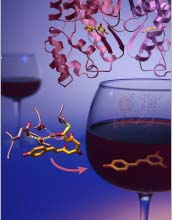|

Press Release 04-119
Scientists Shed Light on Mechanism Behind Beneficial Effects of Red Wine


Compounds found in red wine have health benefits; scientists are discovering the mechanisms by w ...
Credit and Larger Version |
September 17, 2004
ARLINGTON, Va.—Scientists are a step closer to understanding the health benefits of drinking red wine. Researchers funded by the National Science Foundation (NSF) and affiliated with the Salk Institute in San Diego, Calif., have succeeded in converting chalcone synthase, a biosynthetic protein enzyme found in all higher plants, into an efficient resveratrol synthase. Resveratrol, a beneficial component of red wine, is thought to contribute to the improved cardiovascular effects associated with moderate consumption of red wine. The research results appear in the September issue of the journal Chemistry & Biology.
Laboratory studies with resveratrol have demonstrated an impressive list of health benefits, including roles as anti-oxidants, cancer preventing agents, blood thinners and blood pressure -lowering compounds. Resveratrol recently was shown to increase life span in fruit flies and yeast, suggesting an additional role in our diets as a promising anti-aging natural chemical.
"This research demonstrates the power of protein engineering in producing value-added traits, and in solving synthetic puzzles using modern techniques," said William Nes, program director in NSF's division of molecular and cellular biosciences, which funded the research. "The study provides new insights into the relationships among plant proteins."
The health benefits of resveratrol consumption are a lucky accident, scientists say, as grapes actually produce resveratrol in order to defend against fungal invasion. Researchers at the Salk Institute have now deciphered the three-dimensional structure of the plant enzyme that creates this remarkable but rare molecule. In the process, they've resolved a long-standing scientific puzzle: the crucial differences between common plant enzymes known as chalcone synthases and their resveratrol-producing relatives, the much rarer stilbene synthases.
Scientists realized decades ago that chalcones and stilbenes, two important classes of plant natural products with different properties, were produced by closely related enzymatic proteins. All higher plants possess chalcone synthase. Chalcone-derived natural chemicals fulfill a number of important biological functions in plants including roles in plant fertility, disease resistance and flower color. Conversely, production of resveratrol and other rare anti-fungal stilbenes occurs in just a few plant species, including grapevines, peanuts, blueberries and some pine trees.
Using the tools of structural biology, Michael Austin, a graduate student at the Salk Institute and the University of California, San Diego, solved the three dimensional structure of resveratrol synthase and compared its shape to its relative chalcone synthase. Austin is part of a research team led by biochemist Joseph Noel of the Salk Institute. The team has uncovered the crucial differences between these related plant enzymes. "In addition to illuminating the molecular mechanisms of plant evolution, this study has agricultural and nutraceutical significance," said Noel.
Noel and colleagues used their new knowledge to convert a chalcone synthase from alfalfa into an efficient resveratrol-producing factory, simply by changing a few amino acids (the building blocks of proteins). "This biotechnological advance will allow us to 'engineer' natural resveratrol production into crop plants via a small modification of that plant's own chalcone synthase gene, as occurs naturally in grapes and a few other plants," said Noel.
-NSF-

Media Contacts
Cheryl Dybas, NSF (703) 292-7734 cdybas@nsf.gov
Program Contacts
William Nes, NSF (703) 292-7110 wnes@nsf.gov

The National Science Foundation (NSF) is an independent federal agency that supports fundamental research and education across all fields of science and engineering. In fiscal year (FY) 2009, its budget is $9.5 billion, which includes $3.0 billion provided through the American Recovery and Reinvestment Act. NSF funds reach all 50 states through grants to over 1,900 universities and institutions. Each year, NSF receives about 44,400 competitive requests for funding, and makes over 11,500 new funding awards. NSF also awards over $400 million in professional and service contracts yearly.
 Get News Updates by Email Get News Updates by Email
Useful NSF Web Sites:
NSF Home Page: http://www.nsf.gov
NSF News: http://www.nsf.gov/news/
For the News Media: http://www.nsf.gov/news/newsroom.jsp
Science and Engineering Statistics: http://www.nsf.gov/statistics/
Awards Searches: http://www.nsf.gov/awardsearch/
| 

